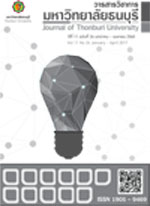ความคิดเห็นที่ยึดถือทรัพยากรขององค์การธุรกิจ: การประเมินคุณค่าของธุรกิจขนาดกลางและขนาดย่อม
Keywords:
ความได้เปรียบในการแข่งขัน, ทรัพยากร, คุณค่า, competitive advantage, resource, valueAbstract
บทคัดย่อ
ธุรกิจขนาดกลางและขนาดย่อม(SMEs) เป็นแหล่งสำคัญของการจ้างงานและรายได้ในหลายประเทศของโลกที่สาม โดยเฉพาะอย่างยิ่งประเทศไทย ถ้าหากว่าธุรกิจขนาดกลางและขนาดย่อมมีอัตราการเจริญเติบโตก็จะส่งผลต่อการเติบโตทางเศรษฐกิจ รวมทั้งการลดลงของอัตราการว่างงานและความยากจน ทั้งนี้เพื่อเสริมสร้างความได้เปรียบในการแข่งขันสำหรับธุรกิจ ผู้ประกอบการจึงควรที่จะต้องเข้าใจอย่างถ่องแท้ถึงที่มาของความได้เปรียบทางการแข่งขัน ดังนั้น ผู้ประกอบการจึงไม่เพียงแต่จะต้องวิเคราะห์ถึงสภาพแวดล้อมภายนอก หากแต่ยังรวมถึงสภาพแวดล้อมภายในที่เป็นทั้งจุดแข็งและจุดอ่อน ทรัพยากรที่องค์การธุรกิจมีนั้นเป็นสินทรัพย์ที่ก่อให้เกิดประสิทธิผลและเป็นปัจจัยที่ถูกนำไปใช้ในการดำเนินธุรกิจโดยที่องค์การธุรกิจเป็นเจ้าของและสามารถควบคุมการใช้ทรัพยากรดังกล่าวได้ ปัจจัยดังกล่าวสามารถถูกแปรสภาพเป็นสินค้าและบริการได้อย่างมีประสิทธิภาพ ยิ่งไปกว่านั้น ผู้ประกอบการสามารถส่งสินค้าหรือบริการดังกล่าวไปยังกลุ่มลูกค้าเป้าหมายเพื่อตอบสนองความต้องการที่มีอยู่และท้ายที่สุดผู้ประกอบการควรจะต้องมีการตัดสินใจในเรื่องของการระบุ การพัฒนา การปกป้องทรัพยากร ความสามารถของทรัพยากรและสมรรถนะหลัก ซึ่งการตัดสินใจที่ถูกต้องจะส่งผลต่อการบรรลุเป้าหมายขององค์การธุรกิจ
คำสำคัญ: ความได้เปรียบในการแข่งขัน, ทรัพยากร, คุณค่า
Abstract
Small and Medium enterprises (SMEs) are the main source of employment and national income in many countries of the Third World, especially Thailand. If they have growth rate , they would contribute to economic growth, unemployment rate and poverty reduction. In order to create competitive advantage, entrepreneurs should have clear understanding of the sources of the competitive advantage. Therefore, entrepreneurs don’t merely analyze the external environment but also a firm’s internal strengths and weaknesses. Resources of the business firms are the assets that make effectiveness and are used in operating the business that are owned and controlled by the firms. These factors can be transformed to products and services efficiently. Moreover, the entrepreneurs can deliver these products or services to target customers for satisfying their needs. And finally, entrepreneur should make decisions in identifying, developing, protecting resources, capabilities and core competencies. The right decisions will effect goal achievement of business firm.
Keywords: competitive advantage, resource, valueReferences
Amit R. and Zott C. (2001). Value Creation in E-Business Strategies. Strategic Management Journal. 22: 493-520.
Bakar and Ahmed. (2010). Assessing the relationship between firm resources and product innovation performance: A resource-based. Business Process Management Journal. 16(3): 420–439.
Barney B.J. (2007). Gaining and Sustaining Competitive Advantage. 3rd edition. New Jersey: Pearson Education, Inc.
Clulow et al. (2007). The resource-based view and value: the customer based view of the firm. Journal of European Industrial Training. 31(1): 19-35.
Darcy C. et al. (2014). A consideration of organizational sustainability in the SME context: A resource-based view and composite model. European Journal of Training and Development. 38(5): 398-414.
Douglas A. et al. (2010). Differentiation for competitive advantage in a small family business. Journal of small business and enterprise development. 17(3): 371-386.
Galbreath J.T. (2004). Determinants of Firm Success: A Resource-Baesd Analysis. Doctor of Philosophy
Hoskisson. R.E. et al. (2008). Competing for Advantage. 2nd ed. Ohio: Thomson Higher Education.
Ireland et al. (2002). Managing strategic alliances to achieve a competitive advantage. Journal of Management. 28: 413-434.
Leanna and Buren (1991). Organizational social capital and employment practices Academy of Management Review. 24(3): 538-555.
Mahoney J. (1995). The Management of Resources and the Resource of Management. Journal of Business Research. 30: 91-101.
Mead D.C. and Liedholm C. (1998). The Dynamics of Micro and Small Enterprises in Developing Countries. World Development. 26(1): 61-74.
Moldoveanu M.C. and Bauer R.M. (2004). On the Relationship Between Organizational Complexity and Organizational Dynamic. Organization Science. 15(1): 98-118.
Wernefelt B. (1984). A Resource-Based View of the Firm. Strategic Management Journal. 5(2): 171-180.







